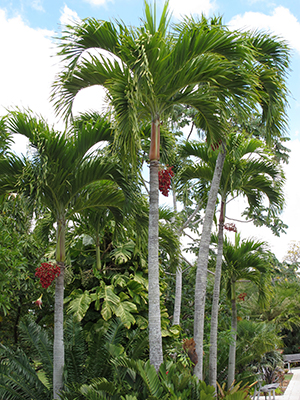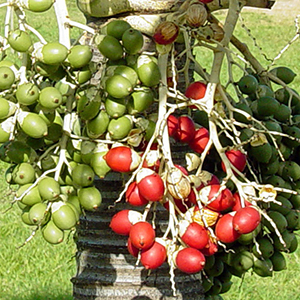Christmas Palm

Christmas palms at the Naples Botanical Garden.
Photo by Scott Zona, some rights reserved.
Palms are one of those iconic Florida plants. They are great for adding tropical flare to the landscape, but if you have a small planting area, finding a palm to fit can be a challenge. Christmas palm (Adonidia merrillii) is one of the few palm species that will do well in a small site.
The common name, “Christmas palm,” comes from the clusters of bright red fruits that adorn these trees in late fall and winter, giving the plants the appearance of being decorated for the holidays. Christmas palms are also sometimes referred to as Manila palms.
Characteristics
Native to the Philippines, these trees have been cultivated throughout the tropics for centuries. They grow quickly until reaching about 6 feet tall then continue to grow more slowly. With time, Christmas palms can grow as tall as 25 feet with a canopy spread of 5 to 8 feet and a 6-inch diameter trunk.
But Christmas palm's main attraction is the fall and winter appearance of very showy clusters of glossy, bright red fruits.
For increased visual interest this single-trunked palm is often planted in groups of two or four. Clumping them like this causes each trunk to grow outwards in a graceful curve. When using this approach, take care to provide enough space for each plant's canopy and root ball—sometimes this method causes competition for growth, with one or more of the plants failing to thrive.
Planting and Care
Christmas palms grow best in full sun but can tolerate partial shade. With the recent history of warm winters, use of Christmas palm in the landscape has migrated north to central Florida, but these palms are only cold hardy to 30°F. Their diminutive size when young makes them a good candidate for containers, which can be moved inside and protected during a freeze. Christmas palm is fairly drought tolerant once established and it is moderately tolerant of salt spray on the foliage.

Detail of the Christmas palm's fruit. Photo by Charles T. Bryson, USDA Agricultural Research Service, Bugwood.org.
These palms are self-cleaning, meaning that once a leaf dies, it drops off cleanly on its own. This characteristic is great for reducing pruning requirements in the landscape.
While these low-maintenance palms are well adapted to Florida’s nutrient-poor soils, they occasionally suffer from boron deficiency. Symptoms of boron deficiency include small, malformed new leaves, multiple unopened spear leaves, and sideways growth.
Christmas palms are relatively disease-free with the exception of lethal yellowing. This disease, as the name would suggest, has no cure. While trees can be protected from lethal yellowing with preventative trunk injections, this is expensive as the palm needs continuous protection for its entire life.
Some gardeners choose to cut off the flower stalks before the fruits develop to avoid the mess from fallen fruits. But others love the look of the attractive red fruits; leaving them on the tree provides you with red-hot cool season color!

